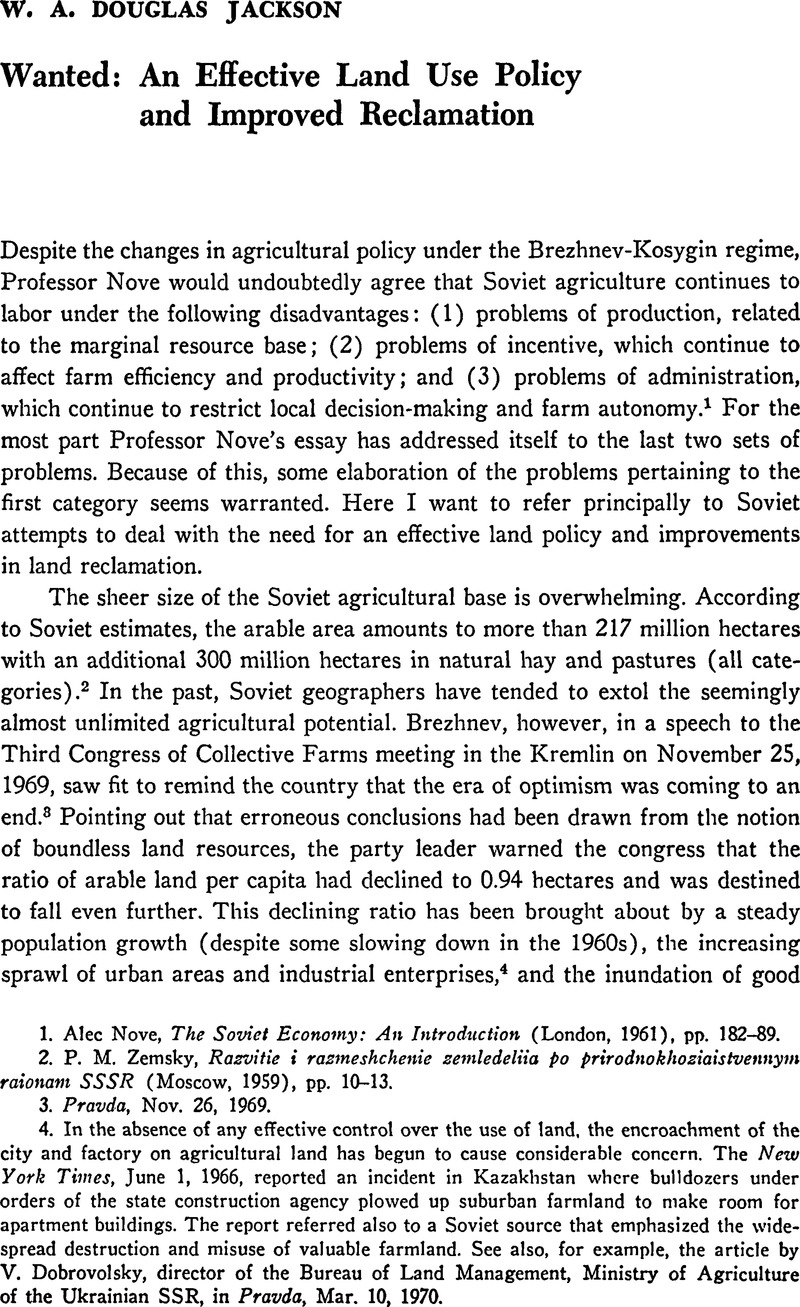Article contents
Wanted: An Effective Land Use Policy and Improved Reclamation
Published online by Cambridge University Press: 27 January 2017
Abstract

- Type
- Discussion
- Information
- Copyright
- Copyright © Association for Slavic, East European, and Eurasian Studies. 1970
References
1. Alec, Nove, The Soviet Economy : An Introduction (London, 1961), p. 182–89.Google Scholar
2. Zemsky, P. M., Rasvitie i rasmeshchenie semledeliia po prirodnokhoziaistvennym raionam SSSR (Moscow, 1959), p. 10–13.Google Scholar
3. Pravda, Nov. 26, 1969.
4. In the absence of any effective control over the use of land, the encroachment of the city and factory on agricultural land has begun to cause considerable concern. The New York Times, June 1, 1966, reported an incident in Kazakhstan where bulldozers under orders of the state construction agency plowed up suburban farmland to make room for apartment buildings. The report referred also to a Soviet source that emphasized the widespread destruction and misuse of valuable farmland. See also, for example, the article by V. Dobrovolsky, director of the Bureau of Land Management, Ministry of Agriculture of the Ukrainian SSR, in Pravda, Mar. 10, 1970.
5. Pravda, Dec. 14, 1969.
6. Ekonomika sel'skogo khosiaistva, 1965, no. 7, p. 87.
7. Akademiia nauk SSSR, Institut geografii, Prirodnye resursy Sovetskogo Soiuza : Ikh ispol'zovanie i vosproisvodstvo (Moscow, 1963), p. 128.Google Scholar
8. Zvonkov, V. V., Vodnaia i vetrovaia eroziia zemli (Moscow, n.d.), p. 87.Google Scholar
9. Forestry and Forest Industry in the US.S.R. (Washington, D.C. : Department of Agriculture, Forest Service, 1961), pp. 18-21. Also G. R. Eitigen, Les v stepi (Moscow, 1959), pp. 4-6.
10. Prirodnye resursy Sovetskogo Soiusa, p. 132.
11. Pravda, Jan. 19, 1968. Indicated in these data are the irrigated areas of the Northern Crimea, which also receive water from the Kakhovka reservoir.
12. Pravda, Nov. 26, 1969.
13. See Vendrov, S. L. et al., “The Problem of Transformation and Utilization of the Water Resources of the Volga River and the Caspian Sea,” Soviet Geography, 5, no. 7 (September 1964) : 23–24 CrossRefGoogle Scholar; N. I., Shishkin, “On the Divergence of the Vychegda and Pechora Rivers to the Basin of the Volga,” Soviet Geography, 3, no. 5 (May 1962) : 46–57 Google Scholar; George A., Taskin, “The Falling Level of the Caspian Sea in Relation to Soviet Economy,” Geographical Revieiv, 44, no. 4 (1954) : 508–27Google Scholar; and also Philip P., Micklin, “Soviet Plans to Reverse the Flow of Rivers : The Kama-Vychegda-Pechora Project,” Canadian Geographer, 13, no. 3 (1969) : 199–215.Google Scholar
14. Dzens-Litovsky, A. I., “K voprosu ob ispol'zovanii vod velikikh sibirskikh rek,” Geograficheskii sbornik, 4 (Moscow, 1954) : 13 Google Scholar; N. A., Mosienko, “Oroshenie v Kulundinskoi Stepi,” Zemledclie, 1964, no. 3, p. 48 Google Scholar. See also Petro, G. A., “Skhema kompleksnogo ispol'zovaniia reki Irtysh,” Problema vodobespecheniia tsentral'nogo Kazakhstan (Moscow, 1960), p. 320–25.Google Scholar
15. Prirodnye resursy Sovctskogo Soiusa, p. 104.
16. Ibid., p. 105.
17. G. A. Mavlianov and S. Sh. Mirzaev, “Conditions and Prospects for Irrigational Development in Central Asia and Problems of Utilization of Underground Waters, “ pp. 7-9, in Abstracts of the Reports, Tashkent Symposium on “The Influence of Irrigation on Secondary Salinization, Chemical Composition and Groundwater Regime,” Tashkent, Aug. 6-12, 1962 (in English). Gerasimov, however, notes that available surface waters would seem to be sufficient to irrigate over 37 million acres (cf. 13 million in 1965), but a “whole series of as-yet-unsolved scientific and technical problems” remain to be solved. I. P., Gerasimov, “Basic Problems of the Transformation of Nature in Central Asia,” Soviet Geography, 9, no. 6 (June 1968) : 445 Google Scholar; see also Robert A., Lewis, “The Irrigation Potential of Soviet Central Asia,” Annals of the Association of American Geographers, 52, no. 1 (1962) : 99–114.Google Scholar
18. Prirodnye resursy Sovetskogo Soiusa, p. 98.
- 1
- Cited by


